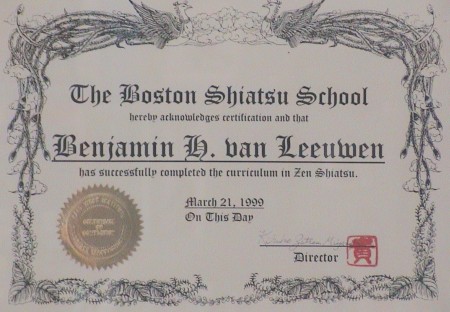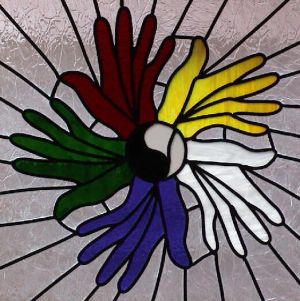|
The Boston Shiatsu School (BSS) Zen Shiatsu Practitioner training was a well-rounded curriculum. In addition to the expected Japanese Shiatsu and Traditional Chinese Medicine (TCM) training, among many others we studied case histories, Western anatomy and physiology, disease pathology; even business and ethics courses. We were required to perform a minimum of treatments in the student clinic, and present the school founder and director with an effective case study. Below is a course review. |
|
Shiatsu Basic Form, Advanced Shiatsu, and Zen Shiatsu: Kikuko Miyazaki(BSS Founder & Director), Patricia Carusone, Dipl. ABT After the
introduction of a thorough Basic Shiatsu course, the upper levels of
the curriculum focused on the Zen Shiatsu teachings established by Shizuto
Masunaga. Just
as there are many styles of massage, there are many styles of Shiatsu;
today, there are even subcategories within Zen style Shiatsu. Masunaga
taught Watari Ohashi and toghether they brought Shiatsu to the U.S.
Basic
TCM and 5 Elements, Advanced TCM, TCM Lab and Practicum:
David Euler, Lic. Ac., Cynthia LaBruzzio, Lic. Ac., Dipl. Ac. This is where the curriculum became complex, enough to make the graduating class about half the size as the first Shiatsu courses. It was an enlightening experience to have these two instructors, with such different styles. Mr. Euler is a dynamic, energetic teacher who breathes life into a clinical atomosphere. His lectures were often as fun as they were informative- no doubt influenced by his partner, Kiiko Matsumoto. Ms. LaBruzzio, on the other hand, is an intellectual, liked to cover a lot of material in each class, and I found her almost difficult to keep up with many times. I am still referring to both of their courses' materials and listening to old lecture tapes, as they contain so much valuable information.
Presenting
the subtleties of Qi, we had the fantastic fortune
of being studying with Osinsei Kuahara. When good teachers are effective,
we have the inspirational experience likened to turning on a light bulb;
Master Kuahara's instruction was like experiencing the Sun up close.
This brilliant syllabus included: Reviewing Masunaga's theory and its relationship to TCM, Integrating Hara Diagnosis with clinical work, Confirmation of Diagnosis, and Exercises to Increase Qi Sensitivity. It was a real treat to attend this very informative weekend workshop, along with many other students, faculty, professionals, alma mater.....Mr. Andrews has an international reputation. It also was interesting to see the same materials from a distinctly British perspective: right, ok, right, brilliant!
This basic
introduction to Chinese Herbology was an excellent experience. In the
class, we became aware of the vast expanse that is Chinese Herbs, and
how they are dispensed. To quote a song, Mr. Wang taught us that there
is a time and purpose for everything under heaven. It may seem odd to
the average American, how much value can be derived from things we consider
trash, like orange peels or
Sotai is a
comprehensive, gentle system of correcting various bodily posture and
structural malignments. It is applied by the practitioner, by providing
physical resistance against the imbalanced area while the client does
most of the work. The best way to describe the therapy is to describe
an example: If uneven shoulders presents, then the client raises the
higher shoulder slowly and forcefully while the practitioner provides
resistance, pushing against the shoulder and downward. All during a
deep exhalation; and when full lung capacity and full scapular elevation
is achieved, the practitioner and client release abruptly and exhale
forcefully.
This course should have been renamed to Fibulas and Fun. Cynthia McDermott is a Professor of Medicine at Harvard University with a strong silly streak. Anatomy study can be tedious and boring, but I always looked forward to her classes; even with the realities of disease pathology. And if you didn't quite grasp something- as I sometimes did- or needed elaboration she was always very personable and available; she even gave us her home phone number. There is no arrogance about her, like one often finds related to Harvard. She shouldered the responsibility of complimenting the East with the West elegantly and with ease. |
Back to Shiatsu New Orleans Home Page

